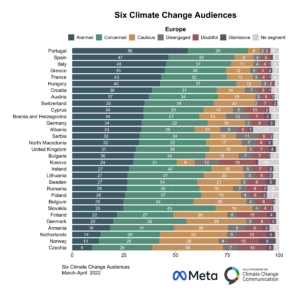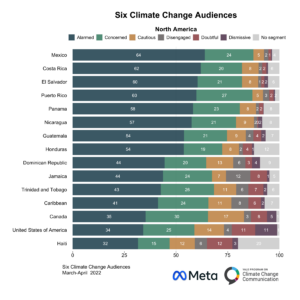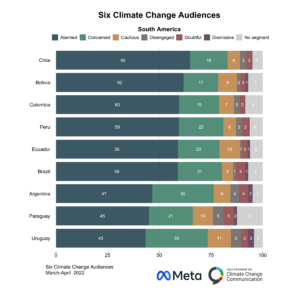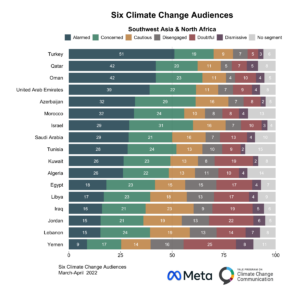Climate Note · Aug 1, 2023
Global Warming’s Six Audiences: A cross-national comparison in nearly 200 countries and territories worldwide
By Marija Verner, Jennifer Marlon, Jennifer Carman, Seth Rosenthal, Matthew Ballew, Anthony Leiserowitz, Nicole Buttermore and Kelsey Mulcahy
Filed under: Audiences and Beliefs & Attitudes

In March and April 2022, the Yale Program on Climate Change Communication (YPCCC) conducted an international survey in collaboration with Data for Good at Meta to examine public climate change knowledge, attitudes, policy preferences, and behavior among Facebook users in nearly 200 countries and territories worldwide.
Prior research by YPCCC and the George Mason University Center for Climate Change Communication has found that people in the United States can be categorized into six distinct groups – Alarmed, Concerned, Cautious, Disengaged, Doubtful, and Dismissive – based on their beliefs and attitudes about climate change (Global Warming’s Six Americas).
The Alarmed are convinced climate change is happening, human-caused, and an urgent threat, and strongly support climate policies. The Concerned think human-caused climate change is happening and is a serious threat, and support climate policies. However, they tend to believe that climate impacts are still distant in time and space, thus the issue remains a lower priority. The Cautious have not yet made up their minds: Is climate change happening? Is it human-caused? Is it serious? The Disengaged know little to nothing about climate change and rarely if ever hear about it. The Doubtful do not think climate change is happening or believe it is just a natural cycle. And the Dismissive are convinced climate change is not happening, human-caused, or a threat, and oppose most climate policies.
The international survey conducted by YPCCC and Data for Good at Meta included the Six Americas Super Short Survey (SASSY), a tool that categorizes respondents into this six audiences framework with just 4 questions. Ideally, one would conduct an in-depth study to develop a tailored segmentation of climate change audiences within each country. However, the Six-Audiences framework and SASSY tool can be used as a first-order approximation and a means of cross-national comparison using an identical set of questions that are relevant in all national contexts.
We find that the Alarmed are the largest group in about three-fourths (80 of the 110) of the countries and territories surveyed. In fact, half or more respondents in twenty-nine countries and territories are Alarmed: the five countries with the largest percentage of Alarmed are Chile (65%), Mexico (64%), Malawi (63%), Bolivia (62%), and Sri Lanka (61%). Czechia and Yemen have the smallest percentages of Alarmed (both 9%). In the United States, about one-third of respondents are Alarmed (34%).
By contrast, relatively few respondents in any country or territory are Doubtful or Dismissive. Among major emitters, the United States has the largest proportion of Doubtful and Dismissive, more than one in five (22%).
The United States is less Alarmed about global warming than most other top carbon-emitting countries
There are substantial differences among the 15 nations responsible for the largest annual shares of global carbon emissions (this study did not include China, Russia, or Iran). Among these countries, the largest proportion of Alarmed are in Mexico (64%), followed by Brazil (59%), and India (55%).
The United States is the second largest annual producer of the carbon emissions that cause global warming. Yet, relatively few people in the United States are Alarmed about global warming, compared to other top emitters. The U.S. and Germany have the fourth-smallest percentage of Alarmed (34%), after the United Kingdom (31%), Saudi Arabia (29%), and Indonesia (27%). On the other end of the Six Audiences spectrum, the countries with the largest percentages of Doubtful or Dismissive respondents are the United States (22%), Saudi Arabia (17%), and Australia (16%).
The Six Audiences by Region
The following charts contain results categorized by region. Among countries in Asia and the Pacific, Sri Lanka has the largest proportion of Alarmed (61%), while Thailand has the smallest (26%). Australia and New Zealand have the largest proportions of Doubtful or Dismissive respondents at 16% and 13% respectively.
Among European countries, Portugal has the largest proportion of Alarmed (56%), while Czechia has the smallest (9%). European countries where more than 10% of respondents are either Doubtful or Dismissive include: Norway (23%), Finland (19%), Kosovo (19%), the Netherlands (19%), Czechia (17%), Sweden (14%), Cyprus (12%), Armenia (11%), Denmark (11%), Germany (11%), the United Kingdom (11%), Bosnia and Herzegovina (10%), Ireland (10%), and Romania (10%).
In North America, Mexico has the largest percentage of Alarmed respondents and is among the countries with the highest percentage globally (64%). Majorities of respondents are also Alarmed in Costa Rica (62%), El Salvador (60%), Puerto Rico (60%), Panama (58%), Nicaragua (57%), Guatemala (54%), and Honduras (54%). By contrast, Haiti has the smallest percentage of Alarmed respondents in North America (32%). Countries with relatively large proportions of Doubtful or Dismissive respondents are the United States (22%), Haiti (15%), and Canada (12%).
Compared to other regions, South America has the greatest proportion of countries (6 out of 9) with a majority of Alarmed respondents. Chile has the largest proportion of Alarmed respondents (65%), while Uruguay has the smallest (43%). Very few people in South America are either Doubtful or Dismissive (7% or fewer in all countries).
In the region of Southwest Asia and North Africa, Turkey is the only country where about half of respondents are Alarmed (51%). In contrast, only 9% of respondents in Yemen are Alarmed. Most countries in this region have over 10% of respondents who are Doubtful or Dismissive, with especially large percentages in Yemen (34%), Jordan (27%), and Iraq (25%).
In Sub-Saharan Africa, Malawi has the largest percentage of Alarmed respondents (63%). Conversely, Nigeria – Africa’s top oil producer – has the smallest proportion of Alarmed respondents, roughly one in three (34%). Countries with relatively large proportions of Doubtful or Dismissive respondents include Nigeria (15%), Benin (12%), Kenya (11%), Congo (12%), and Tanzania (10%).
Methods
The selection of the top 15 emitters was based on World Bank data on total greenhouse gas emissions in 2019, which is the most recent year for which data is available. Our report excludes China, Russia, and Iran, as no survey data were collected from these countries.
The data in this report are based on a survey of 108,946 Facebook monthly active users, aged 18 and older. The survey was conducted from March 25 – April 14, 2022. Sampled Facebook users received an invitation to answer a short survey at the top of their Facebook News Feed and had the option to click the invitation to complete the survey on the Facebook platform.
Audience segmentation is based on the Six Americas Super Short Survey (SASSY), a four-question online questionnaire that allows respondents to identify which segment they belong to (Chryst et al., 2018). Only respondents who answered all four questions were assigned a segment: if they skipped any of the four questions, they were assigned to the “no segment” group.
It should be noted that we have previously reported tailored audience segmentations for a number of countries which identified different numbers of segments (e.g., Global Warming’s Four Indias and Climate Change’s Four Irelands). However, these studies were based on in-depth, nationally representative surveys using different interviewing and segmentation methodologies.






